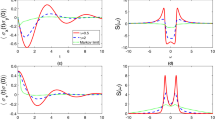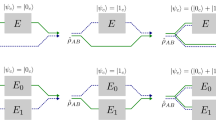Abstract
To study the quantum regression theorem and the Leggett–Garg inequality, two-time correlation functions are calculated for a two-level system which is placed under the influence of a composite environment consisting of two subsystems. Two different configurations, I and II, are considered. In the configuration I, a two-level system of interest interacts with a thermal reservoir via another two-level system. In the configuration II, a relevant two-level system is influenced independently by another two-level system and a thermal reservoir. In both configurations, the thermal reservoir is assumed to have a sufficiently short correlation time. When an interacting nuclear-spin and electron-spin system is considered, the relevant system is a nuclear-spin (electron-spin) in the configuration I (II). It is shown that the quantum regression theorem for the relevant two-level system is always valid in the configuration II while it is not in the configuration I, regardless of whether the reduced time evolution is Markovian or not. Furthermore, it is found that the Leggett–Garg inequality can be violated in both configurations. The dependence of the violation on the parameters characterizing the open two-level system is investigated.





Similar content being viewed by others
Explore related subjects
Discover the latest articles, news and stories from top researchers in related subjects.References
Breuer, H.P., Petruccione, F.: The Theory of Open Quantum Systems. Oxford University Press, Oxford (2006)
Alicki, R., Lendi, K.: Quantum Dynamical Semigroups and Applications. Springer, Berlin (2007)
Rivas, A., Huelga, S.F.: Open Quantum Systems. Springer, Berlin (2012)
Uchiyama, C., Aihara, M., Saeki, M., Miyashita, S.: Master equation approach to line shape in dissipative systems. Phys. Rev. E 80, 021128 (2009)
Saeki, M., Uchiyama, C., Mori, T., Miyashita, S.: Comparison among various expressions of complex admittance for quantum systems in contact with a heat reservoir. Phys. Rev. E 81, 031131 (2010)
Ban, M., Kitajima, S., Arimitsu, T., Shibata, F.: Linear response theory for open systems: quantum master equation approach. Phys. Rev. A 95, 022126 (2017)
Wiseman, H.M.: Weak values, quantum trajectories, and the cavity-QED experiment on wave-particle correlation. Phys. Rev. 65, 032111 (2002)
Ban, M.: Weak measurement on a quantum system in contact with a thermal reservoir: projection operator method. Quantum Stud. 4, 339 (2017)
Barnett, S.M., Radmore, P.M.: Methods in Quantum Optics. Oxford University Press, Oxford (1997)
Ali, M., Zhang, W.: Nonequilibrium transient dynamics of photon statistics. Phys. Rev. A 95, 033830 (2017)
Kubo, R., Toda, M., Hashitsume, N.: Statistical Physics II. Springer, Berlin (1985)
Breuer, H.P., Laine, E., Piilo, J.: Measure for the degree of non-Markovian behavior of quantum processes in open systems. Phys. Rev. Lett. 103, 210401 (2009)
Laine, E., Piilo, J., Breuer, H.P.: Measure for the non-Markovianity of quantum processes. Phys. Rev. A 81, 062115 (2010)
Rivas, A., Huelga, S.F., Plenio, M.B.: Quantum non-Markovianity: characterization, quantification and detection. Rep. Progress. Phys. 77, 094001 (2014)
Breuer, H.P., Laine, E., Piilo, J., Vacchini, B.: Non-Markovian dynamics in open quantum systems. Rev. Mod. Phys. 88, 021002 (2016)
Wolf, M.M., Eisert, J., Cubitt, T.S., Cirac, J.I.: Assessing non-Markovian quantum dynamics. Phys. Rev. Lett. 101, 150402 (2008)
Wolf, M.M., Cirac, J.I.: Dividing quantum channels. Commun. Math. Phys. 279, 147 (2008)
Vega, I., Alonso, D.: Non-Markovian reduced propagator, multiple-time correlation functions, and master equations with general initial conditions in the weak-coupling limit. Phys. Rev. A 73, 022102 (2006)
Goan, H., Jian, C., Chen, P.: Non-Markovian finite-temperature two-time correlation functions of system operators of a pure-dephasing model. Phys. Rev. A 82, 012111 (2010)
Goan, H., Chen, P., Jian, C.: Non-Markovian finite-temperature two-time correlation functions of system operators: beyond the quantum regression theorem. J. Chem. Phys. 134, 124112 (2011)
Leggett, A.J., Garg, A.: Quantum mechanics versus macroscopic realism. Phys. Rev. Lett. 54, 857 (1985)
Emary, C., Lambert, N., Nori, F.: Leggett–Garg inequalities. Rep. Progress. Phys. 77, 016001 (2014)
Ivanov, A., Breuer, H.P.: Extension of the Nakajima-Zwanzig approach to multitime correlation functions of open systems. Phys. Rev. A 92, 032113 (2015)
McCutcheon, D.P.S.: Optical signatures of non-Markovian behavior in open quantum systems. Phys. Rev. A 93, 022119 (2016)
Ban, M.: Double-time correlation functions of two quantum operations in open systems. Phys. Rev. A 96, 042111 (2017); Erratum: Phys. Rev. A 97, 069901 (2018)
Ban, M., Kitajima, S., Shibata, F.: Two-time correlation function of an open quantum system in contact with a Gaussian reservoir. Phys. Rev. A 97, 052101 (2018)
Guarnieri, G., Smirne, A., Vacchini, B.: Quantum regression theorem and non-Markovianity of quantum dynamics. Phys. Rev. A 90, 022110 (2014)
Ali, M., Lo, P., Tu, M.W., Zhang, W.: Non-Markovianity measure using two-time correlation functions. Phys. Rev. A 92, 062306 (2015)
Arimitsu, T., Ban, M., Shibata, : A solvable model of microscopic frequency modulation I: conventional treatment of the damping operator. Physica 123A, 131 (1984)
Apollaro, T.J.G., Lorenzo, S., Franco, C., Plastina, F., Paternostro, M.: Competition between memory-keeping and memory-erasing decoherence channels. Phys. Rev. A 90, 012310 (2014)
Cammack, H.M., Kirton, P., Stace, T.M., Eastham, P.R., Keeling, J., Lovett, B.W.: Coherence protection in coupled quantum systems. Phys. Rev. A 97, 022103 (2018)
Arimitsu, T., Shibata, F.: Theory of exchange dephasing I: general formulation. J. Phys. Soc. Jpn. 51, 1070 (1982)
Bloch, F.: Nuclear induction. Phys. Rev. 70, 460 (1946)
Bloch, F.: Dynamical theory of nuclear induction II. Phys. Rev. 102, 104 (1956)
King, C., Ruskai, M.B.: Minimal entropy of states emerging from noisy quantum channels. IEEE Trans. Inf. Theory 47, 192 (2001)
ban, M., Arimitsu, T.: A solvable model of microscopic frequency modulation II. Physica 129A, 455 (1985)
Ban, M., Kitajima, S., Shibata, F.: Decoherence of entanglement in the Bloch channel. J. Phys. A 38, 4235 (2005)
Nielsen, M.A., Chuang, I.L.: Quantum Computation and Quantum Information. Cambridge University Press, Cambridge (2000)
Fiedenberger, A., Lutz, E.: Assessing the quantumness of a damped two-level system. Phys. Rev. A 95, 022101 (2017)
Author information
Authors and Affiliations
Corresponding author
Appendices
Derivation of Eqs. (8)–(11)
In this appendix, we provide a brief derivation of Eqs. (8)–(11). In the interaction picture, the quantum master equation (2) becomes
where we set \(\tilde{W}_{AB}(t) =e^{i\omega _{A}t\sigma _{A}^{z}+i\omega _{B}t\sigma _{B}^{z}}W_{AB}(t) e^{-i\omega _{A}t\sigma _{A}^{z}+i\omega _{B}t\sigma _{B}^{z}}\). Then we obtain the equations of motion for the operators \(\tilde{W}_{A}^{jk}(t) ={}_{B}\langle j\vert \tilde{W}_{AB}(t)\vert k\rangle _{B}\) of the system A,
The latter two equations yield the solutions,
On the other hand, Eqs. (65) and (66) are rewritten into
with
The matrix \(\mathsf {M}\) is diagonalized as
with
where \(a(\sigma _{A}^{\times })\) is given by Eq. (12). Thus, the solution of Eq. (70) is given by
with
Finally, we obtain Eqs. (8)–(11) in the Schrödinger picture.
A comment on the quantum regression theorem
Two-time correlation functions can be calculated by the formulas provided in Refs. [23,24,25,26]. In particular, using the formula derived in Ref. [26], we can express the two-time correlation function of quantum operations \(X_{1}\) and \(X_{2}\) of a relevant system under the influence of a thermal reservoir as
where \(W(t_{0})\) is an initial density operator of the relevant system and \(\Delta \langle X_{2}(t_{2})X_{1}(t_{1})\rangle \) is a correction term. The reduced density operator W(t) of the relevant quantum system is obtained by solving the time-local quantum master equation [1], \(\partial W(t)/\partial t=\mathscr {K}(t)W(t)\), the formal solution of which is given by \(W(t)=\mathscr {V}(t,t_{0})W(t_{0})\) with \(\mathscr {V}(t,t_{0})=\mathrm {T}\exp \left( \int _{t_{0}}^{t}ds\, \mathscr {K}(s)\right) \). If the second term on the right-hand side of Eq. (80) is negligible, the two-time correlation function can be determined by the solution of the quantum master equation, that is, the quantum channel \(\mathscr {V}(t)\). Up to the lowest order with respect to a system–reservoir interaction, the correction term \(\Delta \langle X_{2}(t_{2})X_{1}(t_{1})\rangle \) is given in the form of
where \(\langle R_{j}(\tau _{2})R_{k}(\tau _{1})\rangle _{R}\) is a correlation function of the thermal reservoir and \(G_{jk}(t_{2},t_{1};\tau _{2},\tau _{1})\) is an appropriate function (please refer to Refs. [26] for details). Here, it is important to note that there is no overlap between the two integrations on the right-hand side of this equation. Hence if the thermal reservoir has a sufficiently short correlation time, the correction term \(\Delta \langle X_{2}(t_{2})X_{1}(t_{1})\rangle \) becomes negligibly small. In the same way, we can show that higher order correction terms are also negligible. In this case, \(\mathscr {K}(t)\) becomes independent of time and \(\mathscr {V}(t,t_{0})=\exp [(t-t_{0})\mathscr {K}]\) is obtained. For the system depicted in Fig. 1, we have the dynamical map \(\mathscr {V}(t,t_{0})=\exp [(t-t_{0})L_{AB}]=V_{AB}(t-t_{0})\) and \(W(0)=W_{A}(0)\otimes W_{B}(0)\). Thus, we can obtain Eqs. (29) and (30) from Eq. (80).
Rights and permissions
About this article
Cite this article
Ban, M. Two-time correlation functions of a two-level system influenced by a composite environment. Quantum Inf Process 17, 317 (2018). https://doi.org/10.1007/s11128-018-2093-5
Received:
Accepted:
Published:
DOI: https://doi.org/10.1007/s11128-018-2093-5




